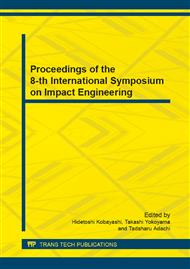p.569
p.575
p.581
p.586
p.593
p.599
p.605
p.611
p.617
Experimental Evaluation of Dynamic Buckling Load of GFRP Rod for Gas Circuit Breaker
Abstract:
Dynamic elastic buckling behaviors of GFRP and Aluminum rods were experimentally investigated. In a gas circuit breaker of an electric power substation, an operating rod consisting of insulating materials is connected to an interrupter. The rod securely insulate between the interrupter and an operating mechanism. The rod is configured with a slender rod made of Glass Fiber Reinforced Plastics (GFRP). When the gas circuit breaker ends the opening operation, impulsive compression load acts on the GFRP rod. To develop a smaller and lighter GFRP rod, dynamic buckling loads of the rod must be studied. In this study, dynamic elastic buckling loads for slender GFRP and aluminum rods were investigated by an experimental method. The drop weight impact tests of the GFRP rods and aluminum rods were employed. In the testing device, a special load cell called the “Load Sensing Block” was used to measure the dynamic load of long time duration. Slender GFRP rods with various lengths were axially loaded at the impact velocities ranging from 0.75m/s to 4.5m/s. From the experimental results, an empirical criterion for the dynamic buckling load of the GFRP rod was proposed in terms of the impact velocity and the slenderness ratio. Furthermore, results showed the proposed criterion could successfully describe the buckling behavior of not only the GFRP rod but also the aluminum rod.
Info:
Periodical:
Pages:
593-598
Citation:
Online since:
June 2014
Authors:
Price:
Сopyright:
© 2014 Trans Tech Publications Ltd. All Rights Reserved
Share:
Citation:


